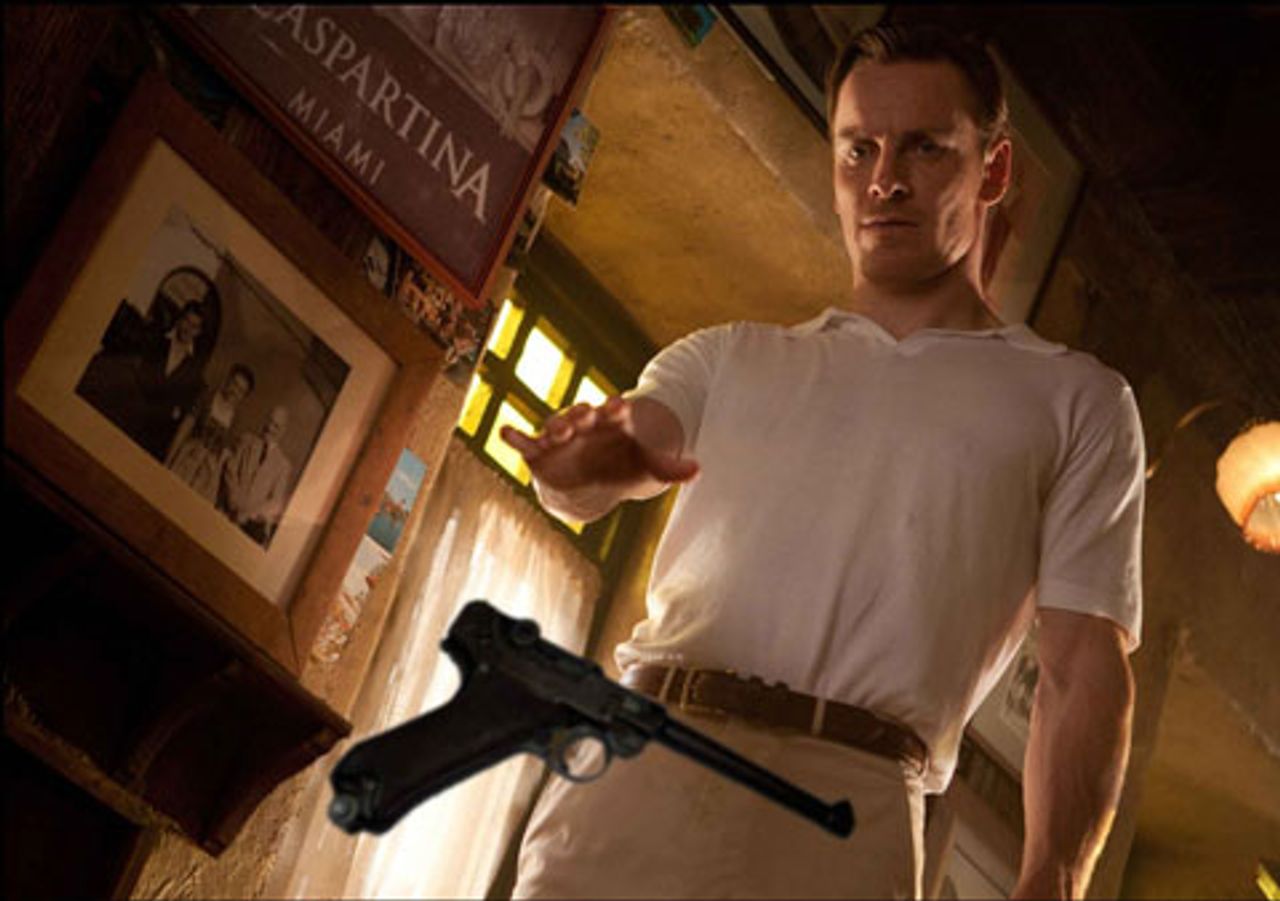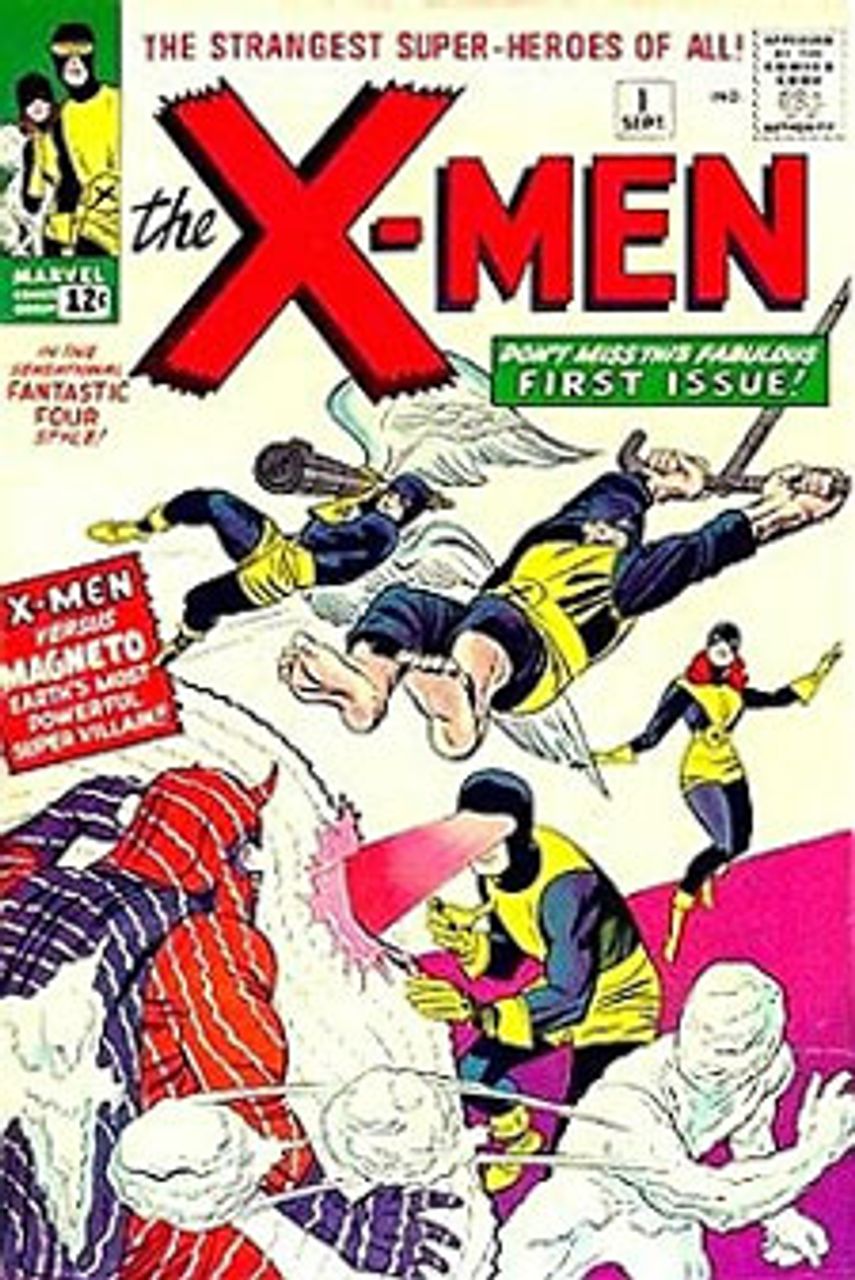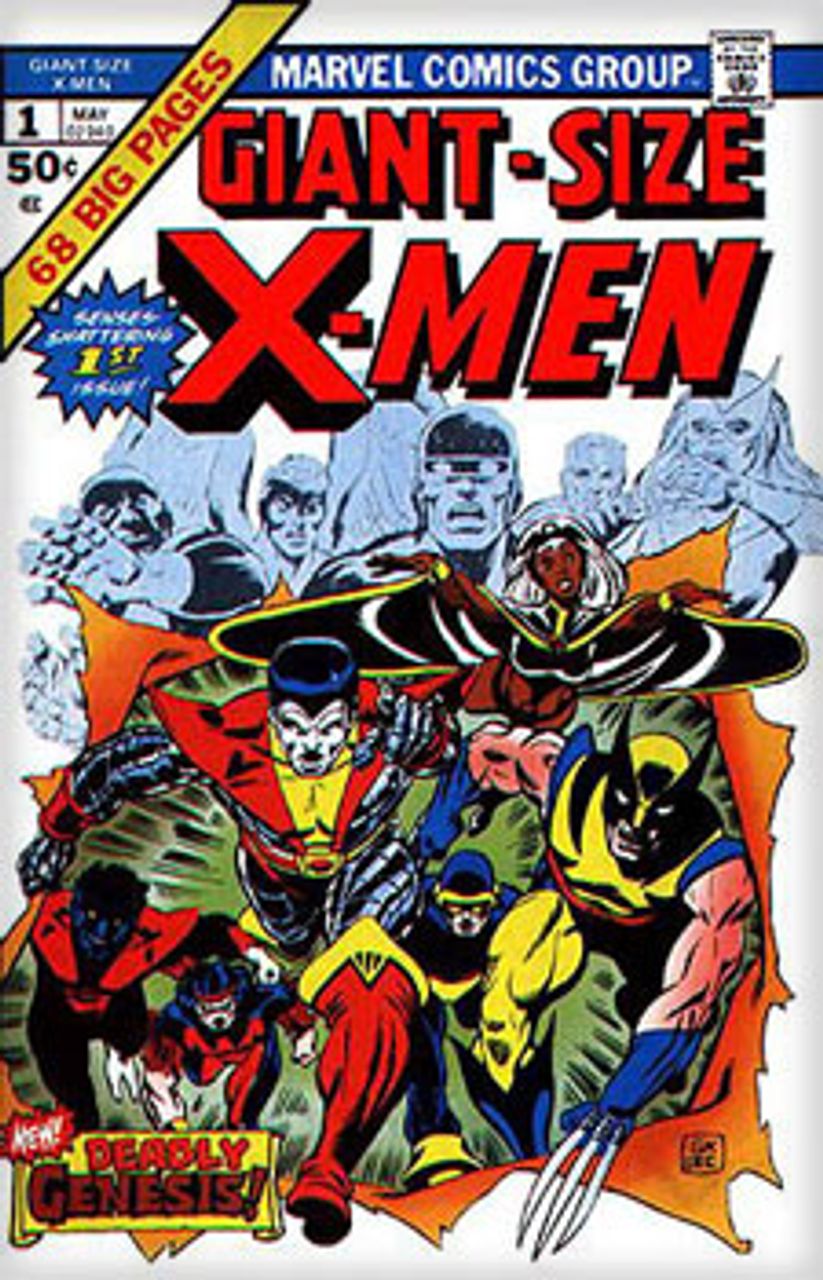Directed by Matthew Vaughn, screenplay by Ashley Miller, Jane Goldman, Zack Stentz and Matthew Vaughn
X-Men: First Class is now the fifth film based on the Marvel Comics series to hit cinema screens. A prequel to X-Men (2000), X2 (2003) and X-Men: The Last Stand (2006), the new film explores the origins of the mutant superhero team, their leader Professor Charles Xavier and their arch nemesis Magneto, master of magnetism. Altogether, these have not been particularly well thought out or profound films.
 X-Men: First Class [Photo: Twentieth Century Fox Film Corporation]
X-Men: First Class [Photo: Twentieth Century Fox Film Corporation]Directed by Matthew Vaughn (Thor), X-Men: First Class is adapted from a screenplay by writers whose résumés include juvenile and science fiction fare such as Agent Cody Banks (2003), Kick-Ass (2010) and the television series Terminator: The Sarah Connor Chronicles (2008–2009). Not surprisingly, X-Men: First Class is rated PG-13, meaning it is aimed at teenagers and adults, with the usual tricks and devices for a blockbuster.
The X-Men series has been particularly profitable for Marvel, and more films are being planned. While fans of the original graphic novels are divided over the films—some praising them and some despising them—the X-Men have been around for forty-eight years, generating interest in at least two generations of readers. There is a view that the X-Men graphic novels and recent film represent social life, but this perspective is mistaken.
Who are the X-Men?
When they first appeared in September 1963, the X-Men were dubbed the “strangest super-heroes of all” conceived “in the sensational Fantastic Four style,” after the team writer Stan Lee and illustrator Jack Kirby had co-created in November 1961. The target readership for Marvel titles was “young kids” to “young people,” and the highly sanitized works were approved by the now-defunct Comics Code Authority (CCA).
The main characters of the X-Men were the noble wheelchair-bound telepath Professor Charles Xavier and his five teenage students at Xavier’s School for Gifted Youngsters in upstate New York. Possessing a genetic X-factor that gave them special powers, the students’ code names were Angel, Beast, Cyclops, Iceman and Marvel Girl. Their main enemy was Magneto, the “Earth’s most powerful super villain,” later revealed to be Xavier’s former friend.
 X-Men, Vol. 1, No. 1, September 1963
X-Men, Vol. 1, No. 1, September 1963
Lee and Kirby were unique in the then-three-decade-old superhero genre for creating superheroes who were not perfect, whom society misunderstood as freaks and whose powers had a “scientific” explanation.[1] The X-Men’s abilities were caused by a mutation that rendered them handicapped in “normal” human society. Cyclops, for example, was blind without a special visor and glasses to control his eyebeams.
Being urban New Yorkers of working-class, immigrant and Jewish background accounts in part for why Lee and Kirby gave their characters handicaps and semi-outsider to outsider status. Readers in the 1960s were not, however, entirely receptive to the X-Men, and the print series was the poorest-selling title at Marvel Comics. That would change after the civil rights movement and when Marvel began to expand its market.
In 1975, the X-Men was relaunched with a new cast of multicultural recruits: Banshee (Irish), Colossus (Russian), Nightcrawler (German), Storm (Kenyan), Sunfire (Japanese), Thunderbird (Native American) and Wolverine (Canadian). While still CCA-approved and lacking the extreme violence and bloodshed now common in Marvel, the outsider mutant heroes were emerging as more socially and personally conflicted.
 Giant-Size X-Men, Vol. 1, No. 1, May 1975
Giant-Size X-Men, Vol. 1, No. 1, May 1975
They were becoming more uncertain about protecting an increasingly hostile human society and more openly debated Professor Xavier’s vision of human and mutant coexistence.[2] But the heroes were basically loyal, while their archenemy Magneto maintained the supremacist vision of mutants as “homo-superior,” the master race. The irony was introduced in 1978 that Magneto survived the Nazi Holocaust at Auschwitz.
Super-epic and realism
While Marvel has striven to humanize its heroes and villains with flaws, insecurities, traumas and weaknesses, the universe these characters inhabit remains a melodramatic and Manichaean one based on the conflict of abstract “good” and abstract “evil.” This is seen, for example, in the name of Magneto’s rival organization: the Brotherhood of Evil Mutants. The too obvious name is not brought up in the X-Men: First Class film.
However much Marvel has attempted to give its characters a semblance of realism on the page and screen, the world the X-Men inhabit is not the real social and historical world, but a half resurrection of the premodern story-world of epic: an absolute, monochronic heroic world beyond possible contact. (See M. M. Bakhtin, “Epic and Novel: Toward a Methodology for the Study of the Novel.”) The world of the X-Men is the commercial and sales-driven world of “super-epic,” a term Stan Lee was using in 1963.
Super-epic, a twentieth-century narrative mode, incarnates a story-world in which action-adventure, fantasy, legend, magic, myth, pop culture, romance, science fiction and soap opera coexist. While real-life problems such as bigotry, hunger, poverty and war may find their way into the genre, the absolute nature of its allegorical universe reduces complex social reality to a binary opposition of contending moral forces.
Since the end of the CCA-dominated era, which began to wane in the 1970s, Marvel has introduced ambiguous, opportunistic, sociopathic and vengeful “heroes” into the super-epic. The X-Man Wolverine has since turned into the sociopathic type, and the glorified vigilante known as the Punisher, whose family was murdered by the mafia, is a case of the vengeance-driven type. Still, the good-versus-evil allegory of the super-epic remains.
As such, a basic problem of the super-epic is that of realism—the mimetic relation to life as it is, in its concrete stability and mobility, in its three dimensions, in its flesh and blood. While the graphic novel is diverse, translating the allegorical universe of super-epic graphic novels to live-action cinema has been fraught with contradictions since superhero films began in the Depression-era 1930s. This is a problem of genre.
While superhero graphic novels and films can be entertaining, the genre limitations of super-epic restrict the artistic exploration of social life. The allegorical and sales-driven nature of the genre ensures that it will depend on cheap gimmicks, cultural stereotypes, formulaic plotlines, moralistic clichés and a generally low level of social consciousness. The abstract moral dualism of the super-epic also lends the genre to state propaganda.
Super-epic Cold Warriors
It is no secret that Marvel Comics collaborates with the United States government.[3] Stan Lee wrote an anti-drug story for the Amazing Spider-Man on the request of the US Department of Health, Education and Welfare (Department of Health and Human Services) in 1971.[4] Marvel also publishes military specials for US servicemen and servicewomen.[5] There are inescapable political implications in this collaboration.
One of the things that stands out in X-Men: First Class is the period setting and its world-historical conflicts: 1962, the Cuban Missile Crisis and the Cold War between the United States and Soviet Union. By contrast, the Cold War and anticommunism were not that central to the hokey X-Men stories of the 1960s, which were almost apolitical and predominantly set in New York, with some occasional appearances by the FBI.
The film, indeed, is at variance with the original print series, breaking with continuity, changing timelines, revising character histories and introducing characters who did not appear until the 1970s and 1980s (e.g., the villains Mystique and Sebastian Shaw). But all of this is allowed in the market-oriented Marvelverse, where alternative realities proliferate. X-Men: First Class is set in a reality Marvel has designated as Earth-10005.
On this super-epic Earth with a “secret history of the Cold War and our world at the brink of nuclear Armageddon” [“About the Movie,” X-Men: First Class], one will find the X-Men as Cold Warriors thrashing Soviet soldiers and protecting US security interests from the Soviet government. As with the premodern genre of the epic, super-epic is built on the “transferral of a represented [heroic] world into the past,” creating a “national heroic past” separate from reality (Bakhtin).
The use of superheroes for propaganda is not new for Marvel. Captain America and Bucky, crude icons of nationalism, beat up Nazis and “Japs” from 1941 to 1945 and were a “Commie smasher” team in 1954 during the McCarthy era. Even Superman at DC Comics has, until recently, been long associated with “truth, justice and the American way.” What is the objective situation for the politics of the latest X-Men film?
Twenty years after the fall of the Stalinist Soviet Union, there is a world capitalist crisis; the global economic position of the US is in decline; traditional markets and spheres of influence are being compromised by rival powers; and Washington is waging foreign wars and occupations to reverse the course of history. On top of this is the reemergence of international class struggle, as marked by events in North Africa and the Middle East.
What is there to X-Men: First Class?
Whether or not there was advice from the government, X-Men: First Class is a superhero political thriller, and there is an ideological orientation to such a film, with a super-epic reality that paints political history in the interests of US foreign policy. The film also addresses youth by portraying anxious young people searching for their place in the world, playing with the human desire for belonging, which also reaches into fiction.
What else is there to X-Men: First Class besides its not unsubtle politics? Basically, the main and secondary stories are carried through the conflicts of a man on a vengeance quest, his encounter with circumstances that try to change his course, his resistance to those circumstances and the execution of his blood vengeance, which, in the end, is not enough for him. Who is this vindictive man, and what is the object of his vengeance?
Nazi hunter and Jewish mutant Erik Lensherr is seeking out ex-Nazi mutant Sebastian Shaw/Klaus Schmidt, who murdered Lensherr’s mother at a concentration camp in order to harness the youth’s magnetic power through rage and then trained him. Meanwhile, Shaw and his three acolytes mastermind the Cuban Missile Crisis, manipulating US and Soviet officials so that humanity will be destroyed and mutants will reign supreme.
Lensherr is recruited by genetics specialist Charles Xavier, who is cooperating with the CIA. The two assemble a team of young mutant G-men from around the US to thwart Shaw and defend America. Lensherr, never accepting Xavier’s beliefs about humanity, attempts to indoctrinate the young mutants. After Lensherr kills Shaw, the US and Soviet navies attempt to wipe out the mutants, leading Lensherr to form his brotherhood.
Artistic truth is the basic problem in art. Nazism, the Holocaust and the Cold War are very serious historical events that are attenuated and trivialized in X-Men: First Class. Does the film correspond to their actual nature, make new artistic discoveries and allow the viewer to experience special psychic states and aesthetic feelings beyond thrills and heroic sentimentalism? Does the film truthfully accentuate and generalize?
Unfortunately, X-Men: First Class is a super-epic fantasy that is walled off from the real world of experience and feeling. The artistic images are hackneyed and one-sided, and the characters are dry, lifeless and formularized. There is no genuine cognition of life here. This is not something that can be compensated for with CGI or a running time that exceeds two hours. Super-epic does not meet up to the demands of social life.
The author also recommends:
The Dark Knight: Striving to be impressive, but essentially empty
[25 July 2008]
Notes
1. Stan Lee, who has no background in science, takes the “scientific” aspect of his Marvel Comics characters as a point of pride. He has said, however, that the X-Men was a product of “laziness and inspiration.” Lee did not have a reason for the characters’ superpowers and decided “they were born that way” as mutants. Bioethicist Paul Root Wolpe of Emory University explains that “genetically, the X-Men make no sense,” and their powers are “utterly implausible as sudden mutations.” See “Stan Lee Speaks about the Mighty Thor,” YouTube, 3 May 2011, http://www.youtube.com/watch?v=oEgIfpb5NHY; “Stan Lee’s X-Men Interview,” YouTube, 1 April 2009, http://www.youtube.com/watch?v=6T76c8x_Dp8; and “X-Men: Science Can Build Them, but Is It Ethical?” YouTube, 26 May 2011, http://www.youtube.com/watch?v=Sh30K_kMyCU.
2. While the X-Men was conceived as unserious entertainment and to generate magazine sales, Stan Lee has said: “When I started the X-Men book I guess I was thinking of bigotry in a way because I liked the theme [that] here were people who were different from the average person, yet they were trying to help the human race, and yet they were being persecuted, and they were being hounded and harassed. I thought there was a lot of irony there, and I thought also there was a lot of symbolism and a lot of truth to it.” See “Stan Lee Talks (2 of 2),” YouTube, 9 December 2007, http://www.youtube.com/watch?v=DTXu7mNKwTw.
3. Marvel Comics has, for example, done projects for the New York City Department of Sanitation, the New York City Fire Department, the US Department of Defense and the US Department of Health and Human Services.
4. The anti-drug story appears in issues 96 to 98 of the Amazing Spider-Man, published May to July 1971. Stan Lee’s previous work for government included “training films and instructional books for the troops,” which he wrote during his enlistment in the U.S. Army during the Second World War. See “Stan Lee Interview 1/3,” YouTube, 8 March 2010, http://www.youtube.com/watch?v=zqijirc45vU.
5. There is, for one, the New Avengers: Marvel Salutes the U.S. Military series, first published in May 2005 and distributed by the Army and Air Force Exchange Services (AAFS). The covers bear the slogans “America Supports You,” after the US Department of Defense program, and “Marvel salutes the real heroes, the men and women of the U.S. military.” The author saw the first issue of New Avengers in Seoul, South Korea, in 2007. See “America Supports You: Marvel, AAFES Offer New Military-Only Comic,” U. S. Department of Defense, 6 December 2006, http://www.defense.gov/news/newsarticle.aspx?id=2321. See also Marvel Military Specials (http://marvelmilitaryspecials.webs.com) and Marvel Comics Database (http://marvel.wikia.com/New_Avengers:_Marvel_Salutes_the_U.S._Military_Vol_1).
